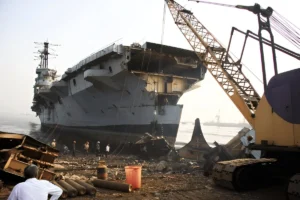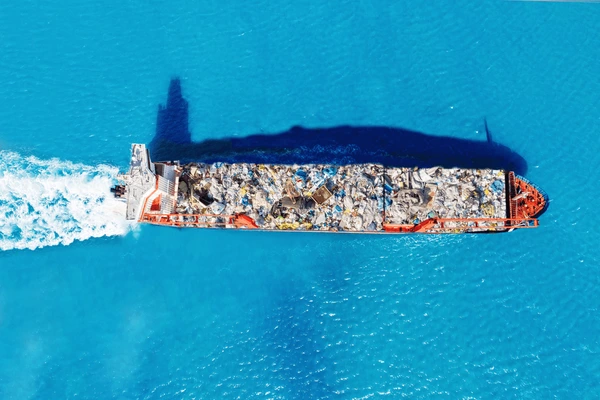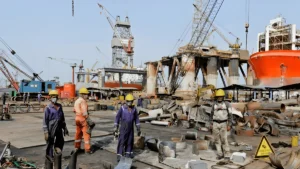How ship waste affects marine ecosystems and what sustainable ship waste disposal means for ocean health. Learn how cleaner practices protect marine life.
Our oceans have always been a source of life, food, and inspiration. But beneath their tranquil blue surface lies an unseen crisis — marine pollution caused by improper ship waste management. Every year, ships discharge millions of tonnes of waste into the sea, including oil residues, sewage, plastics, and chemicals. This contamination disrupts marine ecosystems, harms biodiversity, and threatens global sustainability efforts.
Understanding ship waste disposal in India and its ecological impact is vital for preserving ocean balance and ensuring that maritime operations remain environmentally responsible.
Understanding Ship Waste: What Really Gets Discharged?
Ships generate different kinds of waste, and each type poses unique environmental risks if not managed properly. The most common categories include:
-
Oil residues (sludge and bilge water): Leftover from engine operations and fuel treatment processes.
-
Garbage and plastics: Disposed of during long voyages, often mixed with food waste and packaging materials.
-
Sewage (black and grey water): Produced by crew and passengers onboard.
-
Ballast water: Taken on in one port and discharged in another, often carrying invasive species.
-
Hazardous chemicals: Including cleaning agents, paints, and lubricants used in ship maintenance.
Even small discharges from hundreds of ships over time can collectively have a massive environmental footprint.

How Ship Waste Impacts Marine Ecosystems
The effects of ship waste on marine ecosystems are complex and far-reaching. Each form of waste interacts with ocean life differently — from chemical imbalances to physical pollution.
1. Oil Pollution and Its Toxic Legacy
When oil residues enter seawater, they form a thin film on the surface that blocks sunlight and oxygen exchange. Marine plants, especially phytoplankton, struggle to photosynthesize, leading to reduced oxygen levels in the water. Fish, birds, and mammals that come into contact with oil often suffer from:
-
Skin irritation and poisoning
-
Reduced reproductive capability
-
Hypothermia in birds and mammals due to oil coating on feathers and fur
These effects ripple through the entire marine food chain, creating long-term ecosystem damage.
2. Plastic and Garbage Pollution
Plastic waste from ships can float for years before breaking down into microplastics. Marine animals mistake them for food, leading to ingestion and starvation. Microplastics have even entered human diets through seafood consumption. The cycle of pollution now extends from ship decks to dining tables.
3. Sewage and Pathogenic Contamination
Untreated or poorly treated sewage introduces pathogens, bacteria, and excess nutrients into the ocean. This causes algal blooms — rapid algae growth that depletes oxygen and creates “dead zones” where no marine life can survive. Coral reefs, which thrive in clean, nutrient-balanced water, are among the worst affected.
4. Ballast Water and Invasive Species
Ballast water helps stabilize ships, but it also carries microorganisms and larvae from one region to another. When released, these non-native species can overpower local marine life, disturb natural food chains, and alter entire ecosystems. The zebra mussel invasion in North America is a well-documented example of this problem.
5. Chemical Discharges
Ships often release detergents, paints, and maintenance chemicals that contain toxic substances like heavy metals. These chemicals accumulate in marine organisms and sediments, affecting the health of fish, corals, and seaweeds. Over time, the toxicity disrupts breeding cycles and reduces marine biodiversity.
The Growing Need for Sustainable Ship Waste Disposal in India
India, being one of the largest maritime nations, handles massive ship traffic through ports like Mumbai, Chennai, Kochi, and Kolkata. The demand for ship waste disposal in India has therefore increased due to growing environmental concerns and international compliance requirements.
To address these issues, several initiatives and policies have been implemented, aligning with global standards such as MARPOL (The International Convention for the Prevention of Pollution from Ships). MARPOL sets strict guidelines for ship waste segregation, storage, and discharge limits.
Indian ports have been improving their waste reception facilities and adopting sustainable practices such as:
-
Dedicated port reception facilities for oil, garbage, and sewage waste.
-
Segregation and recycling of ship-generated garbage.
-
Onshore treatment plants for oily and chemical residues.
-
Digital recordkeeping to ensure waste traceability and compliance.
These measures ensure that waste is not dumped at sea and that ships can safely offload waste in compliance with global maritime laws.
Sustainable Practices: The Path to Cleaner Oceans
Creating a pollution-free maritime environment requires more than compliance — it demands innovation, awareness, and collaboration. Sustainable waste management practices include:
-
Regular crew training on waste segregation and handling procedures.
-
Use of eco-friendly cleaning materials and lubricants onboard.
-
Installation of onboard sewage treatment plants and incinerators.
-
Monitoring systems that track waste generation and disposal in real time.
-
Encouraging circular economy models by recycling and reusing waste materials.
Such approaches not only protect marine life but also strengthen a company’s reputation as an environmentally responsible maritime operator.
The Human and Economic Side of Marine Pollution
Marine ecosystem damage doesn’t stay confined to the ocean — it eventually affects people and economies.
-
Fishermen lose livelihoods when fish populations decline.
-
Coastal tourism suffers due to polluted beaches and dead zones.
-
Public health risks increase from contaminated seafood.
-
Marine biodiversity loss impacts scientific research and ocean-based industries.
The ripple effects of poor waste management reach far beyond port boundaries, making sustainable action a shared responsibility.
Awareness and Technology: Driving the Change
Modern technology is playing a crucial role in transforming waste management in the shipping industry. AI, IoT, and data analytics are being used to monitor waste generation and optimize disposal routes. Automated segregation systems, waste compaction units, and digital compliance records are helping ships reduce their environmental footprint.
Furthermore, public awareness campaigns and collaborations between environmental organizations and maritime authorities are educating stakeholders on responsible ship waste management.
Commonly Asked Questions
Q1. What types of waste do ships produce?
Ships produce various types of waste including oil residues, sewage, plastics, hazardous chemicals, and ballast water. Each requires specific handling and disposal methods.
Q2. How does ship waste harm marine life?
Oil and chemical waste can poison fish and marine plants, while plastics cause ingestion and entanglement. Sewage and excess nutrients disrupt oxygen balance, creating uninhabitable zones for marine species.
Q3. What regulations control ship waste disposal in India?
India follows MARPOL regulations and national maritime laws, which mandate proper segregation, storage, and disposal of waste through approved port reception facilities.
Q4. How can the shipping industry minimize its environmental impact?
By adopting sustainable technologies, training crew on waste handling, and using eco-friendly materials, the industry can significantly reduce ocean pollution.
Q5. Why is ballast water a major environmental issue?
Because it can transport invasive species across regions, upsetting the natural balance and causing long-term ecological and economic damage.
A Cleaner Tomorrow for Our Oceans
The ocean’s health mirrors the choices we make on land and at sea. Proper ship waste disposal isn’t just about compliance — it’s about commitment to a sustainable future. As more organizations adopt responsible waste management practices, the dream of pollution-free seas becomes achievable.
With growing awareness and technological innovation, India’s maritime industry is moving toward a cleaner, greener era — one where the harmony between trade and nature can truly thrive.


